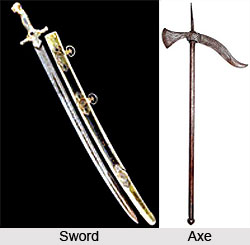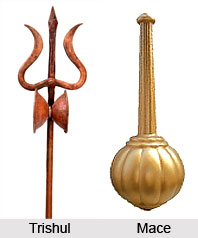 Weapons in Ancient Indian Army were of large varieties. A large number of weapons were used. Some of the most commonly used weapons or astras in the military organisation in ancient India were swords and daggers. Weapons in ancient Indian army were used by hands. Among the twenty-six movable machines listed were rods or pillars with large nails in them. Another popularly used weapon was `sarvatobhadra`, menaing a cart with wheels which could be revolved at fast speed. This was capable of throwing stones in all directions. This machine was also called bhumirika yantra. A bahumukha was a tower built on a fort from where a number of archers could shoot their arrows in all directions. It was provided with leather cover for protection. Preparation also existed for a parjanynka - water machine to put out fire.
Weapons in Ancient Indian Army were of large varieties. A large number of weapons were used. Some of the most commonly used weapons or astras in the military organisation in ancient India were swords and daggers. Weapons in ancient Indian army were used by hands. Among the twenty-six movable machines listed were rods or pillars with large nails in them. Another popularly used weapon was `sarvatobhadra`, menaing a cart with wheels which could be revolved at fast speed. This was capable of throwing stones in all directions. This machine was also called bhumirika yantra. A bahumukha was a tower built on a fort from where a number of archers could shoot their arrows in all directions. It was provided with leather cover for protection. Preparation also existed for a parjanynka - water machine to put out fire.
Weapons with edges like plough-share were known as halamukhani. These were of wood, bamboo, horn or metal and varied in length from two to eight feet. A bow was the main offensive weapon of a soldier. In the early times it was made of Palmyra - tola, bamboo - chapa, wood and bone or horn - singa. At a later date bows were made of thin steel plates and were heavy and cumbersome. Bow strings were made of sinews, bamboo, bark, and hemp, etc. Arrows were thin and long and were made of steel, bone or wood. Great flawlessness had been achieved in their manufacture.
Different weapons were used in different wars. For example, swords were meant for close-quarter battles and were of many varieties. The handles assumed ornamental shapes and were made of horns of rhinoceros, buffalo, and tusk of elephant, wood or root of bamboo.
 Axes of different sizes and shapes also formed a part of the soldier`s equipments. Other offensive weapons were the dagger, javelin, spear, trident or trishul, mace, thunder-bolt and club. The kunta was ten cubits long and was provided with a handle. The pasha was a rod three cubits in length and had three sharp needles in front. The pattislia had sharp edges on both sides along its length and was provided with a handle. A chakra had diagonal bars in the middle and pointed projections on the outer edge. It would be more or less thin like a razor. To give the weapons a super-human touch they were ascribed to various gods such as bolt - Lord Indra, danda - Yama, trishul - Lord Shiva, chakra - Lord Vishnu and so on.
Axes of different sizes and shapes also formed a part of the soldier`s equipments. Other offensive weapons were the dagger, javelin, spear, trident or trishul, mace, thunder-bolt and club. The kunta was ten cubits long and was provided with a handle. The pasha was a rod three cubits in length and had three sharp needles in front. The pattislia had sharp edges on both sides along its length and was provided with a handle. A chakra had diagonal bars in the middle and pointed projections on the outer edge. It would be more or less thin like a razor. To give the weapons a super-human touch they were ascribed to various gods such as bolt - Lord Indra, danda - Yama, trishul - Lord Shiva, chakra - Lord Vishnu and so on.
Tavernier has observed that in ancient times gunpowder was first discovered in Assam from where the knowledge was passed on to Burma and other countries. A long cylindrical pipe - nalika was used and fired like a gun. There was a hole in the rear to ignite the gun-powder. This machine was employed for throwing stones. A sharp point at the front tip of the barrel was used for aiming purposes. Besides these there was a bigger machine which was carried on a carriage. This gun piece fired a ball. All this indicated the active use of gun-powder at the time. Armour or kavach for the protection of the body was made of steel plates, steel-wire nets, skin or cloth. Senior commanders had their armour studded with precious stones. It could cover the whole body including the hands - hastaghana and head - sipra. The different varieties were lohjalika, patta, kavacha and sutraka. Other kinds included padded coats made of cloth and skins.
All the weapons used in ancient Indian Army were kept in safe places and cleaned at regular intervals. The Superintendent of Armoury also known as Ayudha-garadhyaksa was made responsible for ascertaining the demands of the various weapons, their utility in battle and wear and tear with a view to consequent improvement and manufacture. After a campaign the weapons and other allied stores were returned to the armoury. The Superintendent of Armoury was also responsible for the building and defence of forts and making plans for the devastation of the cities or strongholds of the enemy.




















